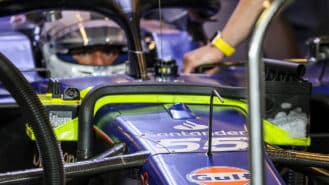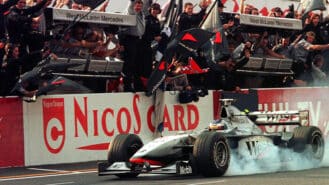2017 cars won’t beat old V10 records and will not be raceable either

It was at the last Motor Sport podcast that Pat Symonds let the cat out the bag – almost as it was happening. He was asked about the proposed 2017 F1 aero regulations – bigger diffuser, wider bodywork, wider front wing, wider and lower rear wing, the return of the beam wing below it, two-metre track, up from 1.8, all changes made to meet with the set task of making the fastest F1 cars ever, that would lop five seconds off current cars and get them under the qualifying lap records set by the V10s over a decade ago.
“Do you know what those changes are?” asked Pat, cryptically.
Well, yes we thought we did…. erm. “Because they are not what I thought they were yesterday. They are very different.”

And so it came out, a scoop right there on the December podcast, one that’s only recently been followed up elsewhere. So now only the two-metre track and the new wings remain of the original agreed changes. The bodywork remains at the current width (even though the track will remain wider), the diffuser doesn’t get bigger – and the lap time reduction is now estimated at two-three seconds rather than five.
Piola and Hughes look at the original 2017 F1 car proposal
Why the change of heart? Because Pirelli pointed out in a meeting last month that its tyres (as currently constructed) could not handle the vast increase in downforce. At least not without greatly increasing the minimum pressures – which of course would reduce the grip and thereby negate much of the laptime improvement!
Pirelli gave an order-of-magnitude estimate of 0.5psi increase for each one second per lap’s-worth of downforce. In light of this, the teams were asked to vote on the watered-down version of the 2017 rules – and did so with an 8-3 majority.
Three seconds faster than current cars will not be enough at most tracks to take them beneath the old V10 qualifying records – and so the whole reason the process was started in the first place will not now be met! In which case, why go to the bother and expense making any aero changes at all? This indeed was what one team – believed to be Red Bull – suggested. But that was dismissed.
So as things stand, F1 is making big changes that it already knows will not meet the original brief – or improve things in any way. The cars will be faster than currently, but still not under the old records. The cars will still be limited by their tyres.
So we stumble into another downside of artificially limiting the tyre performance. Pirelli could in theory produce a more robust construction suitable for cars with a lot more downforce – but then that would mitigate against the stated aim of trying to contrive closer racing through limiting the tyres, and would presumably impact upon the economics of the tyre supply deal that’s already been agreed. As ever, F1 is getting itself in knots over conflicting aims, without a single holistic overall vision of what’s required.

The original 2017 proposal
A single vision might consider abolishing the whole idea of deliberately limiting performance through the tyres. It was a diabolically bad idea when introduced in 2012 – and remains so today. Even without a tyre war, within the constraints of a single, standardised supply, the tyre need not be engineered so as to degrade the way the current Pirellis are designed to. The weak construction around the shoulder is part of the philosophy of this tyre – together with heat-degrading materials within the compounds. It’s constructed so as to place a false ceiling on car performance (so that past a certain point of downforce, more time is lost through greater heat deg than is gained from briefly greater grip – a limit Red Bull found with its blown diffuser cars) and the part-plastic compounds are designed to encourage strategic variation.
But in reality the teams and drivers have quickly understood how to work around the tyre’s limitations. The quickest way to run most races on these tyres is to run less than flat-out for all but a few critical laps around the stops. Which as well as being a betrayal of what F1 is supposed to be about has done nothing for the racing.
From the Archive: Mark Hughes on his Formula 1 vision (April 2014)
It’s also made obsolete – in the dry, at least – the concept of the amazing virtuoso drive against the odds, after an earlier delay perhaps – or in beating the field by a prolonged full blow-torch flat-out drive in a car that isn’t the fastest. And without that, how does F1 create its new legends? Those once-or-twice-a-season special performances from only the very special ones are a crucially important part of the sport’s appeal, the stuff of genius on ragged-edge display. That just doesn’t happen any longer – it can’t. Because of the simplistic idea of using deliberately low-performance tyres on the highest performance cars and drivers.
Also consider this: with current downforce and tyres, all but a couple of tracks allow the power units not to be limited by the 100kg fuel usage limit. With the increased downforce of the 2017 cars, going 2-3s per lap faster, that fuel allocation will come to be limiting. There will be more lift and coasting, ie even less flat-out running than currently – which is already not nearly enough. And the qualifying lap records will still not be broken anyway. So it’s introducing a load of downsides for no upside.
Within the commercial constraints of F1, we need the best drivers forced to drive flat-out in order to win. That also involves one of those conflicting aims – overtaking. The 2017 cars – of either of the most recent proposals – are unlikely to generate better overtaking. Because those proposals were chasing in one-dimension record lap times.
It’s a multi-dimensional problem and only a multi-dimensional solution will work. Part of that multi-dimensional solution would be proper performance tyres that can withstand whatever demands the fastest cars make of them when driven flat out. Another part would be a proper study to find if it is even possible to combine high-downforce cars with workable overtaking (and if not consider banishing downforce from all of racing). A third part would be to have the grids mixed up, so the fastest guys have to find their way through. This has all been said before on this website and in the magazine. But the latest developments on the 2017 cars have just made it plain yet again that F1 as a group is getting the process wrong and so the ‘solutions’ will also be wrong.







